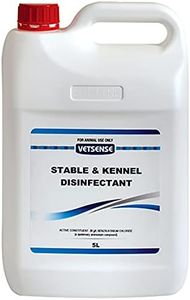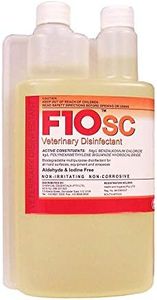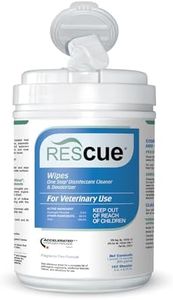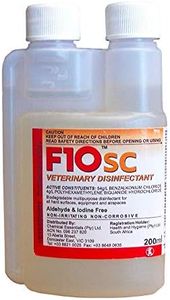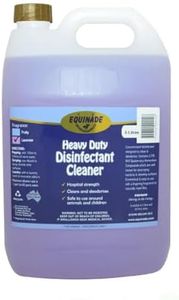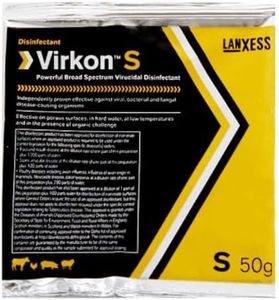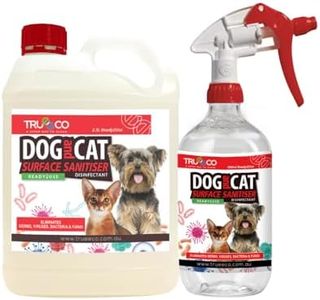We Use CookiesWe use cookies to enhance the security, performance,
functionality and for analytical and promotional activities. By continuing to browse this site you
are agreeing to our privacy policy
10 Best Kennel Disinfectant
From leading brands and best sellers available on the web.Buying Guide for the Best Kennel Disinfectant
Choosing the right kennel disinfectant is important for keeping any area where animals are housed both safe and sanitary. A good disinfectant helps control the spread of disease, eliminates harmful pathogens, and creates a healthier environment for pets and caretakers alike. When searching for the best fit, it's essential to consider the kennel’s needs—how often you'll clean, how many animals you care for, and any sensitivities animals may have. Focusing on key features and understanding how they relate to your use will help you make a more informed choice.Active IngredientsActive ingredients are the chemicals or compounds that actually kill bacteria, viruses, and fungi. This is important because certain pathogens are only eliminated by specific agents, so the effectiveness of a disinfectant largely depends on its active ingredients. Some common examples include quaternary ammonium compounds, bleach, hydrogen peroxide, or accelerated hydrogen peroxide. When reviewing their strengths, quaternary ammonium is generally effective for bacteria and enveloped viruses, bleach is broad-spectrum but can be harsh, and hydrogen peroxide is less toxic but may require longer contact time. Consider what infectious agents are most concerning in your kennel—if you frequently care for animals with contagious conditions, stronger broad-spectrum ingredients may be needed. Conversely, for everyday cleaning in settings with sensitive animals, a gentler active ingredient may be sufficient.
Contact TimeContact time is the amount of time a disinfectant needs to stay wet on a surface to properly kill germs. It’s important because if the product dries before the pathogens are killed, it won’t work as intended. Disinfectants typically range from one minute to ten minutes contact time. Shorter contact times are convenient for busy environments as you can clean quickly, while longer contact times require more patience and may not suit high-turnover kennels. Choose based on your ability to monitor surfaces during cleaning—if you prefer quick cleans or have lots of surfaces, opt for a disinfectant with a short contact time.
Spectrum of ActivitySpectrum of activity refers to the range of pathogens a disinfectant can neutralize, including bacteria, viruses, fungi, and spores. This is a crucial spec because not all disinfectants tackle every type of germ. Some products are only good against a limited range, while others are labeled 'broad-spectrum' and handle almost everything. If your kennel is at risk for multiple types of infections, go for a broad-spectrum disinfectant. If you’re addressing a specific concern, such as a viral outbreak, target a disinfectant that lists effectiveness against that virus specifically.
Safety for Animals and HumansSafety for animals and humans reflects how likely the disinfectant is to cause irritation, allergic reactions, or toxicity if animals lick surfaces or if humans come into contact with it. This is a huge consideration in a kennel since animals often come into direct contact with floors and bedding. Some disinfectants can leave behind harmful residues, while others are formulated to be non-toxic and pet-safe. Divide products into those safe for use around all animals (especially important for puppies, kittens, or animals with health issues) and those needing extra safety steps, such as rinsing after application. Always tailor your choice to the type of animals you house and whether any are especially vulnerable.
Ease of Use and Application MethodEase of use and application method covers how simple it is to prepare and apply the disinfectant. Some products are concentrates that require dilution with water, while others are ready-to-use sprays. Concentrates last longer and can be more economical for large kennels, but require careful mixing to ensure effectiveness. Ready-to-use disinfectants are straightforward but may be better suited for smaller operations or spot cleaning. If you prefer quick and easy application, look for sprays or wipes, but for larger areas or frequent cleaning, concentrated formulas may be more practical.
Residual ActivityResidual activity describes whether a disinfectant continues to work after it has dried, providing ongoing protection from germs. This can be useful in kennels with a constant presence of animals, as it reduces the risk of recontamination between cleanings. Not all disinfectants offer this feature, so check for labels indicating continued or residual activity. If your kennel experiences high traffic or limited cleaning windows, a product with residual protection can help maintain hygiene longer, while standard disinfectants may suffice in lower-risk or low-occupancy settings.
Odor and Staining PotentialOdor and staining potential refers to whether the disinfectant has a strong scent or can leave marks on surfaces. This is important because strong chemical smells can stress animals and affect humans working in the area, while some formulas may stain bedding, flooring, or walls. If you house sensitive animals or have customers visiting, low-odor and non-staining products are a wise choice, whereas stronger-smelling formulas may be acceptable in well-ventilated, non-public spaces.
